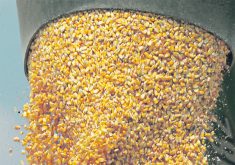Lawrence Yakielashek gave farmers lots of reasons to be bullish about pea prices.
But he moved quickly at the Canadian Special Crops Association’s annual convention to “cool down the bulls.”
Yakielashek, vice-president of Alfred C. Toepfer’s Canadian operations, said reduced acreage, late seeding, cool conditions and the potential of pre harvest frost in Canada could set up a powerful rally in edible pea prices.
But right now the prairie pea crop is not a disaster and people shouldn’t bank on it becoming one.
Read Also

Chinese, Indian tariffs take toll on pea prices
The disruption of pea exports from Canada’s largest customers will likely result in slow pea exports for the remainder of the crop year.
Even if frost causes 30 percent of the peas to drop to feed quality, that would still leave a crop of about 1.85 million tonnes of yellow edibles.
Combined with the forecasted carryover of 500,000 tonnes, it should meet edible market demand.
“When you look at the overall market conditions, we’re probably not so bad after all,” said Yakielashek.
Canadian peas are trading at a big premium to feed grains, so competing feeds are likely to continue nipping at their heels, even though edible peas are able to hold premiums because of their special uses.
Recently Black Sea wheat sold for $139 US per tonne, U.S. and Argentine corn for $162-$163, Ukrainian peas for $190, French peas for $225 and Canadian peas for more than $275.
“It shows you that Canadian pea prices are significantly higher on the overall world scale,” he said.
“We’re going to have to compete on the feed pea side with these other commodities. We already have U.S. corn that’s coming into southern Alberta right now. We’ve got pork production in Canada down 22 percent from three years ago, so we have reduced that demand from the swine sector. We have DDGS directly coming into Western Canada.”
While feed peas face stiff competition, there is potentially a bullish scenario for edible grade peas if more than 50 percent of the crop is hit by frost.
“We’d be in pretty tough shape and we’d probably have to hit the gas pedal on prices pretty fast,” said Yakielashek.
The world would then be short of edible peas, so prices would likely shoot higher.
However, the feed pea market would be swamped and faced with the large supply of cheap feed grains around the world.
“We might have the yellow pea and the feed pea situation completely divorce themselves,” said Yakielashek.
He said there are reasons to be optimistic about pea prices, but no one should make any assumptions yet.
“We may have a potential problem down the way (but) today they don’t look that bad and we have to caution ourselves about getting too excited because there are other people out there in the world who can fill our markets as well.”















